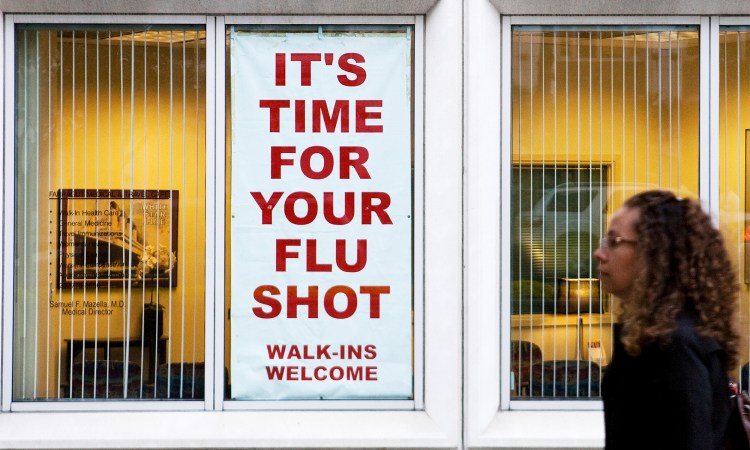
For many of us, getting a flu shot is an annual event.
But you might have wondered: “Why do we need to get one every since year?”
Well, there are two main reasons: The influenza virus is constantly mutating to evade our immune systems, so different strains circulate each year. And because vaccine-induced immunity declines over time, it needs a regular boost.
Unfortunately, the annual flu vaccines we currently have are struggling to keep up with the ever-mutating influenza virus. With an efficacy of 40 to 60 percent, people can find themselves ambivalent about the value of getting a yearly shot or simply not have the time or means to get one every single flu season.
Every year, the seasonal flu infects 1 billion people and kills an estimated 250,000 to 650,000 people worldwide.
Many vaccine researchers are tackling these problems, and they’re working to develop a universal influenza vaccine, which would require just one to three jabs over a person’s lifetime. New breakthroughs in antibody technology in recent years mean this elusive public health goal may be closer than ever before, just when we need it most.
The personal and global healthcare costs of the annual flu season are massive — every year, the seasonal flu infects 1 billion people and kills an estimated 250,000 to 650,000 people worldwide.
On top of this, infectious disease experts have long predicted that another flu pandemic like the 1918 Spanish flu is a matter of “when,” not “if.”
“Throughout history, it’s really respiratory viral pandemics that have infected and killed people across borders and have gone on and on for many years,” says Melvin Sanicas MD, a Philippines based physician-scientist specializing in infectious diseases. Which is why, for almost four decades, scientists have been attempting to create the holy grail of science — a universal flu vaccine.
Developing a flu vaccine still “presents the same level of difficulty as developing an HIV, tuberculosis or malaria vaccine,” says Florian Krammer PhD, professor of vaccinology.
The US National Institutes of Health has four criteria for such a vaccine: that it elicits immune responses against the most widespread and dangerous flu strains, is at least 75 percent effective at preventing illness, provides protection that lasts at least one year, and is effective in all age groups.
Yet even though the flu is no longer a “novel” virus that is new to science, it still “presents the same level of difficulty as developing an HIV, tuberculosis or malaria vaccine,” says Florian Krammer PhD, professor of vaccinology at the Icahn School of Medicine at Mount Sinai in New York City.
This is due to the influenza virus’s intuitive ability to adapt, and avoid immune detection by constantly changing its outer covering, or coat proteins. Influenza A is particularly dangerous, causing 75 percent of flu virus infections, and the infamous bird and swine flu pandemics. Type B and C cause milder illness. There are potentially 198 different influenza A subtype combinations.
Krammer explains Influenza A has two coat proteins — hemagglutinin (HA) and neuraminidase (NA). (Influenza strains are named according to variations in these proteins, such as H1N1.) These proteins are masters of mutation, forming different flu strains that emerge every year. Researchers develop the annual vaccine to match the most dominant circulating strains, but even when a vaccine is well-matched, it is only semi-effective, says Krammer. “The problem is that the virus changes its genetic material every year.”
Bizarrely, there is also a flaw in the virus’s replication process that should be a problem but is actually a superpower. When it makes copies of itself, the virus doesn’t “proof read” them properly to ensure they are identical, so errors are introduced that allow it to change rapidly and to escape human immunity, Krammer explains. That’s why herd immunity doesn’t exist for the flu. It’s also why the quest for a universal vaccine has proved so challenging, and why annual flu vaccines don’t provide long standing protection.
In 2020, early small scale human trials of their vaccine candidate found that it produced a strong immune response that endured for at least 18 months following vaccination.
For the universal flu vaccine, Krammer and the Mount Sinai team are targeting the hemagglutinin coat protein, which allows the virus to invade the respiratory tract. While it may be a skillful shapeshifter, hemagglutinin’s mushroom-shaped structure — consisting of a head and a stalk — lends itself to being genetically manipulated. Taking a novel approach relying on what’s called chimeric hemagglutinins, Krammer and his team have engineered proteins made from the heads of animal influenza subtypes like H5 and H8 and combined them with a stalk from a human influenza subtype like H1 to offer a broader spectrum of protection.
“Our immune system typically responds to the head. The trick is to force it to make antibodies to the stalk. We’ve presented the immune system with a head it hasn’t seen before and a stalk it has seen before, so the body’s immune memory will respond to that first,” explains Krammer. “So after vaccination, the immune system will create protective antibodies in a strong response to the stalk.”
In 2020, early small scale human trials of their vaccine candidate found that it produced a strong immune response that endured for at least 18 months following vaccination. Krammer is confident that this is a major advance with the potential to provide long-lived protection against a spectrum of influenza strains.
However, Sanicas recommends caution. “Everything is promising until it’s not,” he says. “We need to develop chimeric hemagglutinins that represent all or most of the important strains from influenza groups A and B, and that should be tested in a multiyear, phase III clinical study.” Phase III trials are when a vaccine candidate moves from being tested on quite a small group of people in one or two locations to hundreds or even thousands of trial participants across a wider area. The Sinai candidate is still several years from reaching that phase.
A financial investment comparable to what’s been spent on COVID-19 vaccine development — so at least $20 billion in the US alone — is needed to make a universal flu vaccine a reality in two years.
But reaching phase III isn’t a guarantee of success — other universal flu candidates also showed great potential only to fail then. In October 2020, after 15 years of research, Israeli biotech BiondVax Pharmaceuticals announced its universal flu vaccine candidate showed no protection above a placebo in Phase III trials.
In January 2020, Oxford-based biotechnology company Vaccitech discontinued its trial vaccine before reaching Phase III, given that it showed no reduction in infections compared with the seasonal vaccine. But where one vaccine failed, another succeeded. Vaccitech’s co-founder Sarah Gilbert led the development of the Oxford/AstraZeneca vaccine for COVID-19.
Plus, it’s not just technology that’s required to create a successful vaccine; it’s also funding. Krammer believes a financial investment comparable to what’s been spent on COVID-19 vaccine development — that is, at least $20 billion in the US alone — is needed to make a universal flu vaccine a reality in two years. If not, he says the universal flu vaccine research will follow “the usual conservative timeline of about 15 years to go from a new technology to clinical trials.”
Meanwhile, pharmaceutical companies don’t necessarily see the financial incentive of producing a vaccine that would displace the existing get-a-flu-shot-every-year model. Globally the annual flu vaccine is a $4 billion dollar industry. As Krammer puts it, a universal flu vaccine “would be useful in general, reducing the risk of transmission and mutation, but it won’t be a big money maker.”
But what it would be is a game changer offering tremendous benefits for global health by dramatically decreasing cases of the flu and its annual toll. “What we can do is reduce the chance of a new flu pandemic starting, but that can only happen if there’s a high vaccination rate and high immunity,” says Krammer.
Learn more about how the annual flu shot is developed, and why it’s so important to get one:















